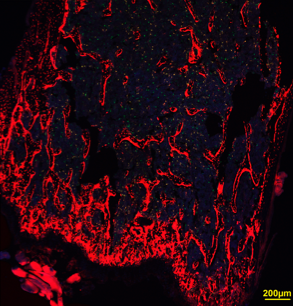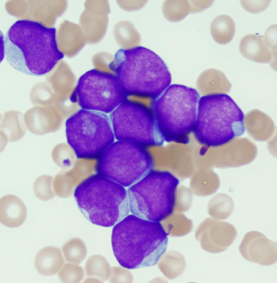Contributions to Science
Regulation of Granulopoiesis
Our laboratory generated a series of transgenic mice carrying targeted (knock-in or knock-out) mutations of the G-CSF receptor (Csf3r) to characterize the role of G-CSF signaling in granulopoiesis. Study of these mice provided new insights into how G-CSF signals regulate hematopoietic progenitor proliferation and differentiation. Our studies also provided insight into how neutrophil egress from the bone marrow is regulated. Specifically, our studies showed that CXCR2 and CXCR4 signaling antagonistically regulates neutrophil trafficking from the bone marrow. More recently, we showed that G-CSF targets lymphoid niches in the bone marrow, suppressing their production of lymphoid trophic factors. These data provide a novel mechanism by which G-CSF induces a switch from lymphopoiesis to granulopoiesis.
- Semerad CS, Poursine-Laurent J, Liu F, and Link DC: A unique role for G-CSF receptor signaling in the regulation of specialized hematopoietic cell function but not lineage commitment or differentiation. Immunity, 1999: 11:153-161
- Semerad CL, Liu F, Gregory AD, and Link DC: G-CSF is an essential regulator of neutrophil trafficking from the bone marrow to blood. Immunity, 2002: 17:413-423.
- Eash KJ, Greenbaum AM, Gopalan PK, and Link DC. CXCR2 and CXCR4 antagonistically regulate neutrophil trafficking from murine bone marrow. JCI, 120:2423-31, 2010. PMCID: PMC20516641
- Day RB, Bhattacharya D, Nagaswa T, and Link DC. Granulocyte colony-stimulating factor reprograms bone marrow stromal cells to actively suppress B lymphopoiesis in mice. Blood, 125:3114, 2015. PMCID: PMC4432005
Mechanisms of Hematopoietic Stem Cell Mobilization
A long-standing interest of our laboratory is to define mechanisms by which G-CSF, the prototypical mobilizing agent, stimulates hematopoietic stem/progenitor (HSPC) egress from the bone marrow. Our lab was the first to show that G-CSF targets osteoblast lineage cells, suppressing their transcription of CXCL12. We showed that G-CSF signaling in monocyte-lineage cells is sufficient to initiate the HPSC mobilization cascade. More recently, we have focused on defining the effects of G-CSF on stem cell niches in the bone marrow. We showed that CXCL12 production from distinct bone marrow stromal cell populations regulates distinct subsets of HPSCs.
- Semerad CL, Christopher M, Liu F, Short B, Simmons PJ, Winkler I, Levesque JP, Chappel J, Ross P, and Link DC. G-CSF potently inhibits osteoblast activity and CXCL12 mRNA expression in the bone marrow. Blood, 106:3020-7, 2005. PMCID: PMC1895331
- Christopher MJ, Liu F, Hilton MJ, Long F, and Link DC. Suppression of CXCL12 production by bone marrow osteoblasts is a common and critical pathway for cytokine-induced mobilization. Blood, 114:1331-9, 2009. PMCID: PMC2727413
- Christopher JM, Rao M, Liu F, Woloszynek JR, and Link DC. Expression of the G-CSF receptor in monocytic cells is sufficient to mediate hematopoietic progenitor mobilization by G-CSF in mice. JEM, 208:251-60, 2011. PMCID: PMC3039862
- Greenbaum A, *Hsu MS. Day RB, Schuettpelz LG, Christopher MJ, Borgerding JN, Nagasawa T, Link DC. CXCL12 production by early mesenchymal progenitors is required for hematopoietic stem cell maintenance. Nature, 495:227-30, 2013. PMCID: PMC3600148
Molecular Pathogenesis of Severe Congenital Neutropenia
Our laboratory showed that truncation mutations of the G-CSF receptor that reproduce somatic mutations (often found in patients with severe congenital neutropenia (SCN)) result in the clonal expansion of hematopoietic stem cells that is dependent, in part, on accentuated STAT-3 activation. Our laboratory was the first to propose a novel model of disease pathogenesis in SCN associated with mutations of ELANE. Specifically, we showed using a novel transgenic mouse line and patient samples that mutant ELANE results in the activation of the unfolded protein response and induction of apoptosis in granulocytic precursors.
- McLemore M, Grewal S, Liu F, Archambault A, Poursine-Laurent J, Haug, J, and Link DC: STAT-3 activation is required for normal G-CSF-dependent proliferation and granulocytic differentiation. Immunity, 2001: 14:193-204.
- Grenda DS, Murakami, M, Ghtak, J, Boxer LA, Dale D, Bolyard AA, Dinauer MC, and Link DC. Mutations of the ELA2 gene found in patients with severe congenital neutropenia induce the unfolded protein response and cellular apoptosis. Blood, 110:4179-87, 2007. PMCID: PMC2234798
- Liu F, Kunter G, Krem M, Eades W, Cain J, Tomasson M, Henninghausen L, and Link DC. G-CSF receptor mutations found in patients with severe congenital neutropenia induce hematopoietic stem self-renewal that is mediated by STAT5. JCI, 118:946-55, 2008. PMCID: PMC2248325.
- Nanua S, Murakami M, Grenda D, Woloszynek JR, Xia J, Strand M, and Link DC. Activation of the unfolded protein response is associated with impaired granulopoiesis in transgenic mice expressing mutant Elane. Blood, 117:3539-47, 2011. PMCID: PMC3072877
Molecular Pathogenesis of Acute Myeloid Leukemia
We were the first show that in healthy subjects individual HSPCs accumulate mutations as a function of age. This led us to test and provide evidence for a novel model of for leukemic progression in therapy-related AML. Specifically, our data suggest that HSPC clones with preexisting aging-related mutations of TP53 undergo selective expansion upon exposure to cytotoxic therapy (for the primary cancer).
- Welch, J.S., Ley, T.J., Link, D.C. (co-first author), Miller, C.A., Larson, D.E., Koboldt, D.C., Wartman, L.D., Lamprecht, T.L., Liu, F., Xia, J., et al. The origin and evolution of mutations in acute myeloid leukemia. Cell, 150:264-78, 2012. PMCID: PMC3407563
- Link DC, Schuettpelz LG, Shen D, Wang J, Walter MJ, Kulkarni S, Ivanovich J, LeBeau M, Koboldt DC, Dooling DJ, Fulton RS, Schmidt H, Maupin R, O’Laughin M, Chen K, McLellan MD, Varghese N, Nagarajan R, Graubert T, Ding L, Ley TJ, Zambetti GP, Wilson RK, and Mardis ER. The identification of a novel TP53 cancer susceptibility mutation through whole-genome sequencing of a patient with therapy-related AML. JAMA, 305:1568-76, 2011. PMCID: PMC3170052.
- Wong TN, Ramsingh G, Young AL, Miller CA, Touma W, Welch JS, Lamprecht T, Shen D, Hundai J, Fulton RS, Heath S, Baty JD, Ding L, Mardis ER, Westervelt P, DiPersio JF, Walter MJ, Graubert TA, Ley TJ, Druley T, Link DC (corresponding author), and Wilson RK. The role of TP53 mutations in the origin and evolution of therapy-related AML. Nature, 515:552-5, 2014. PMCID: PMC4403236
- Wong TN, Miller CA, Klco JM, Petti A, Demeter R, Helton NM, Li T, Fulton RS, Mardis ER, Westervelt P, DiPersio JF, Walter MJ, Welch JS, Graubert TA, Wilson RK, Ley TJ, and Link DC. Non-malignant oligoclonal hematopoiesis commonly follows induction chemotherapy for adult de novo AML. Blood, 127:893-7, 2016. PMCID: PMC4760092
Clonal Hematopoiesis
We provide evidence that specific stressors, both cell autonomous and non-cell autonomous contribute to the development of clonal hematopoiesis. Specifically, we show that genotoxic stress contributes to the expansion of hematopoietic stem cell clones carrying mutations in DNA response genes. Moreover, we showed that truncation mutations of the G-CSF receptor confer a competitive advantage to HSCs in the presence of G-CSF. Finally, we recently showed that ribosomal stress present in Shwachman Diamond Syndrome result in the selective expansion of hematopoietic clones carrying mutations of TP53.
- Liu F, Kunter G, Krem M, Eades W, Cain J, Tomasson M, Henninghausen L, and Link DC. G-CSF receptor mutations found in patients with severe congenital neutropenia induce hematopoietic stem self-renewal that is mediated by STAT5. JCI, 118:946-55, 2008. PMCID: PMC2248325
- Wong TN, Miller CA, Klco JM, Petti A, Demeter R, Helton NM, Li T, Fulton RS, Mardis ER, Westervelt P, DiPersio JF, Walter MJ, Welch JS, Graubert TA, Wilson RK, Ley TJ, and Link DC. Non-malignant oligoclonal hematopoiesis commonly follows induction chemotherapy for adult de novo AML. Blood, 127:893-7, 2016. PMCID: PMC4760092
- Xia J, Miller CA, Baty J, Ramesh A, Jotte MRM, Fulton RS, Vogel TP, Cooper MA, Walkovich KJ, Makaryan V, Bolyard AA, Dinauer MC, Wilson DB, Vlachos A, Myers KC, Rothbaum RJ, Bertuch AA, Dale DC, Shimamura A, Boxer LA, Link DC. Somatic mutations and clonal hematopoiesis in congenital neutropenia. Blood. Epub Nov 1, 2017. PubMed PMID: 29092827.
- Wong TN, Miller CA, Jotte MRM, Nusayba B, Baty JD, Schmidt AP, Cashen AF, Duncavage EJ, Helton NM, Fiala M, Fulton RS, Heath SE, Janke M, Luber K, Westevelt P, Vij R, DiPersio JF. Welch JS, Graubert TA, Walter MJ, Ley TJ, and Link DC. Cellular stressors contribute to the expansion of multiple hematopoietic clones of varying leukemic potential. Nat. Comm., 9:455, 2018.

